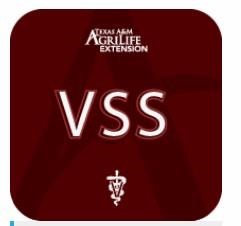With the touch of a smartphone button, veterinarians will be able to check online to determine if what they see in the field is unique to their area or part of a greater pattern, thanks to a new veterinary app and website created by a group of Texas A&M AgriLife faculty.

VSS app icon.
The Veterinary Syndromic Surveillance System, VSS, website and app are now live and will provide veterinarians a tool to access and input disease information to a central database, said Tom Hairgrove, DVM and Ph.D., Texas A&M AgriLife Extension Service cattle veterinary specialist in the Texas A&M University Department of Animal Science, Bryan-College Station.
Hairgrove is leading a three-year “Improving the Sustainability of Rural Veterinarians Through Mentoring, Targeted Education, Telemedicine and Monitoring of Disease Syndromes” project, funded by a U.S. Department of Agriculture National Institute of Food and Agriculture grant.
The VSS website and app meet one of the goals set out within that grant — to provide quality continuing education in production medicine and participation in real-time disease surveillance, thereby providing practitioners, students and veterinary technicians with an increased awareness of state and regional livestock disease issues.
Hairgrove said they have been working on the proof of concept for about six months. Only veterinarians can download the VSS app, which is found in the Apple Store and can also be downloaded to android phones. All the information goes back to a server that AgriLife Extension owns.
A graduate student, Debbie Perry, who is also the compliance officer in the Department of Animal Science, helped create the tools. Karun Kaniyamattam, Ph.D., post-doctorate research associate, did the artificial intelligence work. Both are in the Department of Animal Science.
Animal health regulatory agencies in Texas, New Mexico and Arizona are involved in the project, Hairgrove said. The goal is to create a network of rural practitioners linked together through virtual reporting and diagnostic tools so that veterinarians in underserved areas feel more engaged and part of a larger group experiencing similar issues in production agriculture.
Updated technology
The new app is populated by veterinarians, along with the Veterinary Technology Program at Texas A&M University-Kingsville. Senior vet students are also using it to document records during their externships with private practitioners, Hairgrove said.
The difference between this app/website version and previous ones is that the artificial intelligence will be able to pick up any flags on disease trends or syndromes that might go with a disease, Hairgrove said.
“Each day, there is a map with flags, and we can look at all the counties by zip code to see the disease syndromes in any area. They build upon one another,” he said. “The central database will be mined using artificial intelligence to sort through the information and provide feedback to practitioners.”
Also, the old app required an iPad. But the new app allows everything to be done on the smartphone, and most of the information can be added in just a few minutes.
“The way we built this, the veterinarians can enter their notes for their own records, which is automatically sent back to their clinic and not shared with anyone else,” he said. “They can enter confidential information, and it does not go into the database. After spending a lot of time with producers prior to developing this, we know that anonymity is a priority to them.”
The greater picture, then, is a website where veterinarians can see their individual data or go to the map and see syndromes that everyone has flagged.
“They can note they are seeing a lot of one symptom and find out if anyone else is as well,” Hairgrove said. “Then they can communicate back and forth on these issues. We hope we can get more people coming out of school who realize the advantage of this.”
Real-time information meets artificial intelligence
Hairgrove said the new technology tools provide real-time information to veterinarians and state or federal regulatory veterinarians concerning the location and prevalence of disease syndromes in large animals.
Artificial intelligence will monitor that information and help build maps that will flag the various symptoms, thus allowing veterinarians to develop a diagnostic plan based on current surveillance data.
“For instance, say we have an issue with open cows or prussic acid toxicity in cows,” Hairgrove said. “Some people might think these symptoms are happening because it didn’t rain. With this app, we can determine if the weather is playing a role or if what is occurring is an isolated instance.”
The new technology initially is targeting early career veterinarians, he said. Many times, young, early career veterinarians in rural areas practice in isolation and have limited communication with other veterinarians, nutritionists, reproductive specialists or other groups who support food animal agriculture.
However, they are the practitioners on the front lines and will be the first to encounter emerging, reemerging and transboundary livestock diseases, so what they see is very important.
Source : tamu.edu